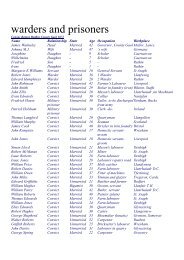pdf, 378.05 KB - Denbighshire County Council
pdf, 378.05 KB - Denbighshire County Council
pdf, 378.05 KB - Denbighshire County Council
You also want an ePaper? Increase the reach of your titles
YUMPU automatically turns print PDFs into web optimized ePapers that Google loves.
3 Warriors and Farmers: Iron Age people of the<br />
Clwydian hillforts c.1,000B.C.-A.D.43<br />
The people of Iron Age <strong>Denbighshire</strong> lived in a<br />
far harsher world than their Bronze Age<br />
predecessors. A catastrophic deterioration in<br />
climate, by rendering much of the uplands unusable,<br />
had increased competition for the remaining<br />
farmland, and produced a divided, warlike society<br />
dominated by chieftains and warriors. Weapons<br />
- increasingly made of iron - and defence were<br />
now more important than ‘sacred landscapes’,<br />
and in place of burial mounds and ritual circles<br />
communities now built the fortified settlements<br />
called ‘hillforts’.<br />
<strong>Denbighshire</strong>, indeed, boasts some of the most<br />
spectacular hillforts in Wales: most notably the<br />
famous chain along the Clwydian Hills, watching<br />
over the fertile vale below. No less than six occur<br />
within 15 miles (22.5 km), from Moel Hiraddug<br />
near Dyserth in the north, via Moel y Gaer (Bodfari);<br />
the vast 52 acre (21 ha.) fort of Penycloddiau<br />
near Llangwyfan and Moel Arthur less than a mile<br />
away; to Moel y Gaer on the slopes of Moel<br />
Famau and powerful Foel Fenlli above Llanbedr<br />
Dyffryn Clwyd.<br />
Protected by their ditches and ramparts - originally<br />
reinforced by stone or timber walling - the people<br />
of these fortress villages lived in circular huts,<br />
whose outlines can still be traced after heather<br />
clearance. Excavations at nearby Moel y Gaer<br />
(Rhosesmor) revealed that such huts might be<br />
up to 38 feet(11.5 metres) in diameter, with a<br />
ground area comparable to a modern bungalow.<br />
Well planned and organized, these hillfort<br />
communities were doubtless controlled by<br />
tribal chieftains. Their people spoke a language<br />
recognizably akin to modern Welsh: they<br />
worshipped gods connected with water, sacrificing<br />
in bogs, pools and springs such prized possessions<br />
as the ornate iron firedog discovered at Capel<br />
Garmon (now in Conwy) or the splendid bronze<br />
shield mountings from Moel Hiraddug hillfort.<br />
The warlike farmers of Iron Age <strong>Denbighshire</strong><br />
clearly appreciated fine craftsmanship.<br />
Places to visit<br />
Penycloddiau, Moel Arthur and Foel Fenlli hillforts<br />
are all on Offa’s Dyke Path. Moel Arthur is directly<br />
accessible from the car park immediately below.<br />
Turn right off the B5429 at the roundabout north<br />
of Llandyrnog; take the second minor road left,<br />
continuing to the top of the pass. From Moel<br />
Arthur it is a short (1.5 km) walk north to Penycloddiau.<br />
A much longer (6.5 km) walk south from the car<br />
park (beginning with a sharp climb) leads to the<br />
summit of Moel Famau and on to Foel Fenlli.<br />
Foel Fenlli is also accessible from Llanbedr Dyffryn<br />
Clwyd: take the minor road off the main A494<br />
Ruthin-Mold road just after the sharp hairpin<br />
bend in the village, park about a mile further on,<br />
and walk up Offa’s Dyke path. Other hillforts<br />
worth visiting are Caer Drewyn, Corwen (enquire<br />
at local One-StopShop for route) and Moel y<br />
Gaer (Llangollen), accessible via a strenuous<br />
walk from the Horseshoe Pass.<br />
For all these visits, walking boots, good weather<br />
and determination are required.<br />
Moel Arthur. © Crown Copyright RCAHMW.<br />
5




